It’s about that time: summer! While summer is fun for a multitude of reasons—new nail polish colors, cute Havana hats, and a casual wardrobe—it’s also time to start taking your skincare routine seriously. Wearing sunscreen every day is the most important beauty routine to stick to during the summer.
Chemical Sunscreens
Chemical sunscreens are the typical sunscreens you find in drugstores and are usually the first thing you reach for.
What makes it a chemical sunscreen? The most common main ingredients in chemical sunscreens are usually Oxybenzone, Octinoxate, and other hard-to-pronounce ingredients along these lines. Chemical sunscreens can help protect your skin against the sun but do not provide an actual barrier between the UV rays and your skin, allowing some rays through. That’s why it’s necessary to get a higher SPF and reapply every 60–90 minutes.
Spray sunscreen or sunscreen lotion? There are tons of different kinds of chemical sunscreens, like lotions and sprays with names like "sport" or "sheer." What kind of sunscreen you use depends on your skin type. The sheer sunscreens might be too light for you; the sport sunscreens might be too heavy, causing you to actually sweat more. Usually, sprays are better for people who apply sunscreen correctly and often. But for the rest of us, sprays may miss spots since you can’t see exactly where the sunscreen has been applied.
Sunscreen rules: Apply at least 30 minutes prior to sun exposure. Do not apply on top of moisturizers; sunscreen should be the very first thing you apply to your skin. Use a broad-spectrum sunscreen that will protect against both kinds of UV rays: UVA and UVB. Another way to make sure the sunscreen you are buying is the best is to make sure it is recommended by the Skin Cancer Foundation, which will be listed on the bottle.
Spray: Coola Sport Continuous Spray SPF 30, $32 at Sephora.
Lotion: Banana Boat Sport Performance Lotion SPF 30, $6.50 at drugstores.
Physical Sunscreens
Physical sunscreens are less common than chemical sunscreens.
What makes it a physical sunscreen? Two main ingredients, Titanium Dioxide and Zinc Oxide, characterize physical sunscreens. Pure Zinc is thought to be the most effective form of sun protection—think pure white lotion that does not rub sheerly onto your skin. These should be the only two main and active ingredients in your physical sunscreen in order for it to be characterized as a true physical sunscreen. These ingredients provide an actual barrier between your skin and the UV rays. This means that if applied correctly, your skin is completely protected from skin-damaging and sunburn-causing UVA and UVB rays.
Spray sunscreen or sunscreen lotion? Finding a physical sunscreen in spray form is pretty hard, but they do exist. These sunscreens tend to be thicker and don’t easily disappear on skin like their chemical counterparts, which is why physical sunscreens most commonly come in lotion form. You’ll often see physical sunscreens described as "mineral sunscreens" too.
Sunscreen rules: Just like chemical sunscreens, these physical sunscreens should be applied at least 30 minutes before sun exposure and reapplied often.
Spray: Bare Republic Mineral Sport Sunscreen Body Spray SPF 30, $14.99 at Target.
Lotion: Neutrogena Pure & Free Baby Broad Spectrum SPF 60, $10–$15 at drugstores.
Don’t Forget Your Face!
When it comes to sunscreen, your face is just as important as the rest of your body. The face can show signs of sun damage faster than anywhere else.
Chemical or Physical? It’s up to you to decide what kind of coverage your face needs. However, if you’re going with a chemical sunscreen, make sure that the SPF is at least 30 and broad spectrum, plus check to make sure the bottle reads "non-comedogenic" so it won’t clog your pores or do more damage to your skin.
Sunscreen Rules: Apply at least 30 minutes before sun exposure and make sure to reapply to your nose most often. If you’re wearing makeup with sunscreen in it, make sure to wear sunglasses and a hat to protect your face!
Chemical: DR. Jart+ Every Day Sun Fluid Broad Spectrum SPF 30, $34 at Sephora.
Physical: MD Solar Sciences Mineral Crème Broad Spectrum SPF UVA-UVB Sunscreen, $30 at MD Solar Sciences. Also comes with tinted options.
What About Those Lips?
Our lips are probably the number one most overlooked area when it comes to sunscreen—most likely because nobody wants to slather their lips in white goo. Fortunately, there are chapsticks and lip balms with sunscreen!
Chemical or Physical? There are not many physical sunscreens out there—but chemical ones can do the job just as well.
Sunscreen Rules: Apply as often as possible: every few minutes, after every drink, and after every meal. This is the place where the sunscreen will wear off the fastest, so we have to be diligent with the application!
Chemical: Supergoop! Acai Fusion Lip Balm Broad Spectrum SPF 30, $9.50 at Sephora.
Physical: Juice Beauty SPF 8 Lip Moisturizers, $10 at Juice Beauty. Comes in a variety of colors.


(0) comments
We welcome your comments
Log In
Post a comment as Guest
Keep it Clean. Please avoid obscene, vulgar, lewd, racist or sexually-oriented language.
PLEASE TURN OFF YOUR CAPS LOCK.
Don't Threaten. Threats of harming another person will not be tolerated.
Be Truthful. Don't knowingly lie about anyone or anything.
Be Nice. No racism, sexism or any sort of -ism that is degrading to another person.
Be Proactive. Use the 'Report' link on each comment to let us know of abusive posts.
Share with Us. We'd love to hear eyewitness accounts, the history behind an article.